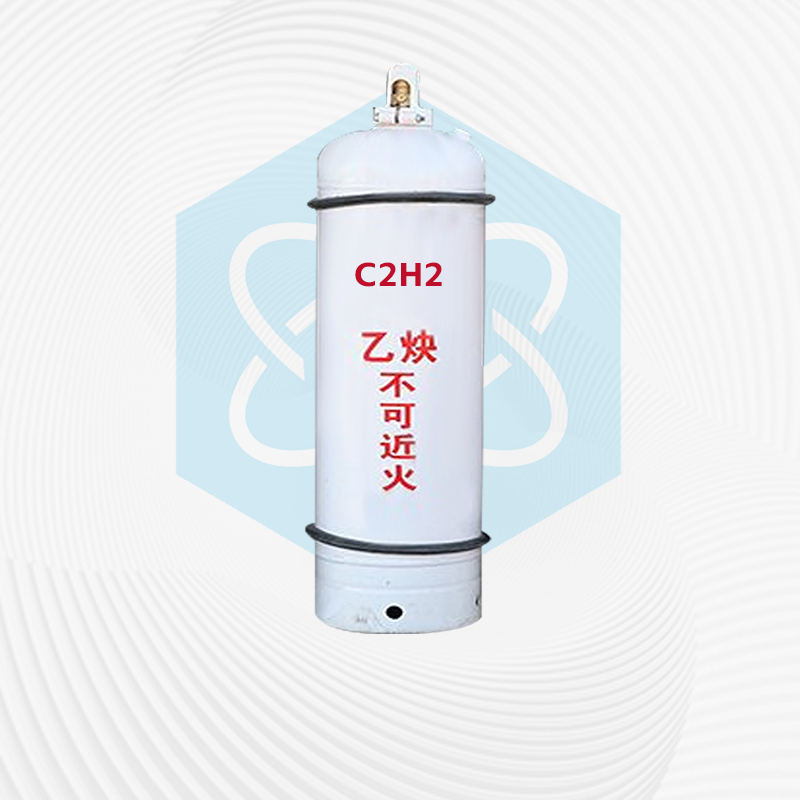ဓာတ်ငွေ့ဖော်ပြချက်
လေကျောက်မီးသွေးနှင့် ကာဗိုက်ဓာတ်ငွေ့ဟု အများအားဖြင့် သိကြသည့် မော်လီကျူးဖော်မြူလာ C2H2 ပါရှိသော Acetylene သည် အယ်ကိုင်းဒြပ်ပေါင်းစီးရီး၏ အသေးငယ်ဆုံးသော အဖွဲ့ဝင်ဖြစ်ပြီး အထူးသဖြင့် သတ္တုများကို ဂဟေဆော်ရာတွင် စက်မှုလုပ်ငန်းအတွက် အဓိကအားဖြင့် အသုံးပြုပါသည်။ Acetylene သည် အခန်းအပူချိန်တွင် အရောင်မဲ့ပြီး မီးလောင်လွယ်သောဓာတ်ငွေ့ဖြစ်သည်။ သန့်စင်သော acetylene သည် အနံ့မရှိသော်လည်း စက်မှုလုပ်ငန်းသုံး acetylene တွင် ဟိုက်ဒရိုဂျင်ဆာလဒ်နှင့် ဖော့စဖင်းကဲ့သို့သော အညစ်အကြေးများကြောင့် ကြက်သွန်ဖြူကဲ့သို့ အနံ့ရှိသည်။
အဓိကအသုံးပြုသည်။
Acetylene ကို မီးထွန်းခြင်း၊ ဂဟေဆော်ခြင်း၊ ဖြတ်တောက်ခြင်း သတ္တုများ (oxyacetylene flames) များအတွက် အသုံးပြုနိုင်ပြီး acetaldehyde၊ acetic acid၊ benzene၊ synthetic rubber, synthetic fibers စသည်တို့ကို ထုတ်လုပ်ရန်အတွက် အခြေခံကုန်ကြမ်းတစ်ခုလည်းဖြစ်သည်။
Acetylene လောင်ကျွမ်းမှုသည် မြင့်မားသော အပူချိန်ကို ဖြစ်ပေါ်စေနိုင်ပြီး သတ္တုများကို ဖြတ်တောက်ခြင်းနှင့် ဂဟေဆက်ခြင်းအတွက် အသုံးပြုသည့် oxyacetylene မီးတောက်၏ အပူချိန်သည် 3200 ℃ ဝန်းကျင်သို့ ရောက်ရှိနိုင်သည်။ သင့်လျော်သောလေပမာဏကို ပေးခြင်းဖြင့် လုံးဝလောင်ကျွမ်းစေပြီး တောက်ပသော အဖြူရောင်အလင်းရောင်ကို ထုတ်လွှတ်နိုင်သည်။ လျှပ်စစ်မီးကို တွင်တွင်ကျယ်ကျယ် အသုံးမပြုသော သို့မဟုတ် လျှပ်စစ်မရှိသောနေရာများတွင် အလင်းရောင်အရင်းအမြစ်အဖြစ် အသုံးပြုနိုင်သည်။ Acetylene သည် တက်ကြွသော ဓာတုဂုဏ်သတ္တိများ ရှိပြီး ဓါတ်ပေါင်း များစွာဖြင့် ထပ်လောင်း တုံ့ပြန်မှုကို ခံရနိုင်သည်။ 1960 ခုနှစ်များမတိုင်မီက acetylene သည် အော်ဂဲနစ်ပေါင်းစပ်မှုအတွက် အရေးကြီးဆုံးကုန်ကြမ်းဖြစ်ပြီး ယနေ့ခေတ်တွင် အရေးကြီးသောကုန်ကြမ်းများထဲမှ တစ်ခုအဖြစ် ကျန်ရှိနေပါသည်။ ဟိုက်ဒရိုဂျင်ကလိုရိုက်၊ ဟိုက်ဒရိုဂျင် ဆိုင်ယာနိုက် သို့မဟုတ် အက်ဆစ်အက်ဆစ်ဖြင့် ပေါင်းထည့်ပါက၊ ၎င်းသည် ပိုလီမာများထုတ်လုပ်ရန်အတွက် ကုန်ကြမ်းအားလုံးကို ထုတ်လုပ်နိုင်သည်။
Acetylene သည် ဗီနိုင်းအက်စီတလင်း သို့မဟုတ် divinyl acetylene ကိုထုတ်လုပ်ပေးသည့် မတူညီသောအခြေအနေများအောက်တွင် ကွဲပြားသော ပိုလီမာတုံ့ပြန်တုံ့ပြန်မှုကို ခံယူနိုင်သည်။ ကလိုရိုပရင်းရော်ဘာထုတ်လုပ်ရန်အတွက် 2-chloro-1,3-butadiene ကုန်ကြမ်းရရှိရန် ယခင်ကို ဟိုက်ဒရိုဂျင်ကလိုရိုက်ဖြင့် ပေါင်းထည့်နိုင်သည်။ Acetylene သည် မြင့်မားသော အပူချိန် 400-500 ℃ တွင် benzene ဖွဲ့စည်းရန် cyclic triple polymerization ကို ဆောင်ရွက်နိုင်သည်၊ နီကယ်ဆိုက်ယာနိုက် Ni (CN) 2 ကို ဓာတ်ကူပစ္စည်းအဖြစ် အသုံးပြု၍ cyclohexene ကို 50 ℃ နှင့် 1.2-2 MPa တွင် ထုတ်ပေးနိုင်သည်။
Acetylene သည် မြင့်မားသောအပူချိန်တွင် ကာဗွန်နှင့် ဟိုက်ဒရိုဂျင်အဖြစ်သို့ ပြိုကွဲသွားပြီး acetylene ကာဗွန်အနက်ရောင်ကို ပြင်ဆင်နိုင်သည်။ အချို့သောအခြေအနေများတွင်၊ acetylene ပေါ်လီမာပြုခြင်းသည် benzene၊ toluene၊ xylene၊ naphthalene၊ anthracene၊ styrene၊ indene စသည်တို့ကဲ့သို့ မွှေးကြိုင်သော ဟိုက်ဒရိုကာဗွန်များကို ထုတ်ပေးပါသည်။ အစားထိုးခြင်းနှင့် ထပ်လောင်းတုံ့ပြန်မှုများမှတစ်ဆင့် တန်ဖိုးကြီးသောထုတ်ကုန်များကို ထုတ်လုပ်နိုင်ပါသည်။ ဥပမာအားဖြင့်၊ acetylene dimerization သည် vinyl acetylene ကိုထုတ်ပေးသည်၊ ထို့နောက် chloroprene ကိုရရှိရန် ဟိုက်ဒရိုဂျင်ကလိုရိုက်နှင့် ထပ်လောင်းတုံ့ပြန်မှုတစ်ခုကိုခံယူသည်။ acetaldehyde ထုတ်လုပ်ရန် acetylene ၏ တိုက်ရိုက်ရေဓါတ်၊ Acetylene သည် ဗီနိုင်းကလိုရိုက်ထုတ်လုပ်ရန် ဟိုက်ဒရိုဂျင်ကလိုရိုက်နှင့် ထပ်လောင်းတုံ့ပြန်မှုကို ခံယူသည်။ Acetylene သည် ethylene acetate ကိုထုတ်လုပ်ရန် acetic acid နှင့် ဓာတ်ပြုပြီး၊ Acetylene သည် acrylonitrile ထုတ်လုပ်ရန် ဟိုက်ဒရိုဂျင် ဆိုင်ယာနိုက်နှင့် ဓာတ်ပြုသည်။ Acetylene သည် methylpyridine နှင့် 2-methyl-5-ethylpyridine ထုတ်လုပ်ရန် အမိုးနီးယားနှင့် ဓာတ်ပြုသည်။ Acetylene သည် methylstyrene ၏ isomers သုံးခုကိုထုတ်လုပ်ရန် ဓာတ်ကူပစ္စည်းတစ်ခုမှ အက်စီတလင်းဖြင့် အက်စီတီလင်းကိုထုတ်လုပ်ရန် toluene နှင့် ဓာတ်ပြုသည်။ Acetylene နှင့် acetone သည် methylpropanol ကိုထုတ်လုပ်ရန် ထပ်လောင်းတုံ့ပြန်မှုကိုခံရပြီး isoprene ကိုထုတ်လုပ်ရန် ဓာတ်ပြုသည်။ Acetylene သည် ကာဗွန်မိုနောက်ဆိုဒ်နှင့် အခြားဒြပ်ပေါင်းများ (ဥပမာ- ရေ၊ အယ်လ်ကိုဟော၊ သီအိုလ်) တို့နှင့် ဓာတ်ပြုပြီး acrylic acid နှင့် ၎င်း၏ ဆင်းသက်လာမှုများကို ထုတ်လုပ်သည်။




